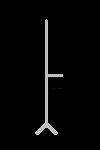"B"

Beith (Birch)
"The
Lady of the Woods" 
"Beware; Seven attempts will be made
to take your wife
into the Underworld.."
Book
of Ballymote - 14th Century
The White Birch fidh should be gathered during a full
moon so that it will possess the pure essential powers of
love and rebirth. As a tree of rebirth, Birch was
sometimes used to make hats for the dead to wear between
lifetimes (while within the grave). It's class is
peasant, its symbolic color is white and its month was
December/January. When casting the fedha, interpret the
Beith Ogham's influence to show a new beginning, or a
purification of some previous wrong. This is the tree
associated with Bóann, mother of Angus, mistress of The
Dagda, and a possessor of the Draíocht of the Well of
Segais. The white tree grows amid the scorched black of a
forest. The White Way spreads across the blackness of
never-ending space. The White Brugh of Bóann leads to
the rebirth of the Sun.
Tone: f (Chase & Paulik); e ' (ÓBoyle)
Magical Ogham: bríocht
(-aí) - spell, largely or fully verbal (the modern form
of the word is spelled, and pronounced, with a short
"i", briocht). (CNL) This spell or charm
generally consists of either two lines or six lines.
Lines with eight syllables precede those having only four
syllables. It is primarily used for protection but can be
used in battles; also can be spelled: bricht or breacht.
(SOD)
Skill Ogham: bethumnacht
- livelihood.
Color Ogham: bán
- "white".
Word Ogham of Morann Mac Main:
Feocus foltchain ("faded trunk and fair hair").
These words bring me the image of a lone woman of great
age facing the future with optimism, even though she has
been through some difficulties at times. I sense that
eternity stretches out behind her, but I also see many
eternities yet to come. Many times, a hero is faced with
the choice of embracing the Hag in order to achieve
greatness and reward. In the presence of such a woman, a
woman of white age, a need for purification and
commitment surge within my breast. Purification.
Word Ogham
of CúChulainn: Maise malach ("beauty of the
eyebrow"). In his typically direct way,
CúChulainn is indicating the archway of the sky as it
spans the beginnings of Creation. The eyebrow frames the
all-knowing, all-seeing eye of the Mother Goddess. The
arch of the brow indicates a warning and perhaps a bit of
surprise. It is also very possible that the
"eyebrow" being discussed here is referring to
the private parts and the place of birthing. Initiation.
Word Ogham of
Mac ind Óic: Glaisium cnis ("most silvery of
skin"). The vision of silvery skin adds a
Magical characteristic to the already poignant image of
the Goddess initiating creation. I see a sheen of silvery
light surrounding and purifying Her purpose. The silver
of the Holy Grail comes to mind. Manifestation .
Word Ogham of
ÓDubhain: Toil beatha ("will to live").
My overall impression of this Ogham is that it shows the
Will of Creation to constantly struggle against
adversity. The persistence of life is symbolized by the
regrowth of the Birch within the burned out forest and
upon the fields of the retreating glaciers. The Sun
itself returns to shine upon the Brugh of Creation and
life springs eternally forth from the ashes of the past.
The fundamental words for "B" are Beith and Bas
(Life and Death) Since this is the first Ogham, I have
chosen its meaning to represent. Will.
The Will to Live
Past, Present, and Future Meanings:
Foundations
of Mastery
Initiation into Life
Manifestation of Dreams
The Nine Dúile of
Beith:
Purification of Structure: Fasting,
Fasting of Flesh: Cleansing,
Cleansing of Growth: Baptism,
Baptism of Blood: Initiation,
Initiation of Spirit: Being,
Being of Dreams: Manifestation,
Manifestation of Perception: Beginnings,
Beginnings of Thoughts: Consciousness,
Consciousness of Power: Will.
Tales to Read and
Study:
"The Tale of Boann and the
Well of Segais",
Brugh na Bóinnde I & II - Metrical Dindshenchas,
The Book of Leinster, 1160 CE, (Also available in Volume
2
of the Metrical Dindshenchas by Edward Gwynn).
"The Conception of Lugh"
_Cath Mage Tuired,_
Folklore,
"The Tale of Lugh's Wife",
The Book of Ballymote, 14th Century CE.
"The Birth of CúChulainn", Cóir Anmann.
"The Story of Taliesin",
"hwell Taliesin.
"Cad Goddeu"
Top of Page
Bach to Aicme
Back to the Class Outline
[_members/blfsnhdtcqmgngstraoueieaoiuiioae/members/daireclass/_private/_amrún_foot.htm] |